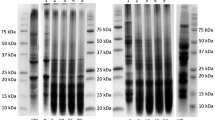Abstract
Proteins extracted from defatted oats were chemically modified by acylation (succinylation and acetylation), potassium linoleate treatment or partial hydrolysis with trypsin. Total essential amino acid content was slightly lowered by acetylation, but unaffected by succinylation. Gel filtration chromatography showed some dissociation of oat polypeptides by succinylation, while trypsin hydrolysis caused considerable breakdown of the protein. Solubility and emulsifying properties were significantly improved by all the modifications. Fat binding capacity was improved by acylation and linoleate treatment, while water hydration capacity and foaming properties were improved by trypsin and linoleate modifications. The gelling property was improved by acylation. When meat protein was substituted with oat protein in model wieners, there was a decrease in cook yield, cohesiveness and firmness. However, when compared to the unmodified oat protein, succinylation led to an improvement in performance in an emulsified meat system.
Similar content being viewed by others
References
Ma, C.-Y.Cereal Chem. 60:63 (1983).
Ma, C.-Y.Can. Inst. Food Sci. Technol. J. 16:201 (1983).
Grant, D.,Cereal Chem. 50:47 (1973).
Franzen, K.L., and J.E. Kinsella,J. Agric. Food Chem. 24:788 (1976).
Childs, E.A., and K.J. Park,J. Food Sci. 41:713 (1976).
Beuchat, L.R.,J. Agric. Food Chem. 25:258 (1977).
Kabrirulah, M., and R.B.H. Wills,J. Food Technol. 17:235 (1982).
Johnson, E.A., and C.J. Brekke,J. Food Sci. 48:722 (1983).
Nakai, S., L. Ho, M.A. Tung and J.R. Quinn,Can. Inst. Food Sci. Technol. J. 13:14 (1980).
Jones, L.J., and M.A. Tung, Ibid.:57 (1983).
Ma, C.-Y.,J. Food Sci. 49:1128 (1984).
Ma, C.-Y.,Can. Inst. Food Sci. Technol. J. 18:77 (1985).
Kramer, A., and J.V. Hawbecker,Food Technol. 20:29 (1966).
Raymond, D.P., C.J. Randall and P.W. Voisey,Can. Inst. Food Sci. Technol. J. 13:174 (1980).
Randall, C.J., D.P. Raymond and P.W. Voisey, Ibid.:216 (1976).
Voisey, P.W., and C.J. Randall,J. Texture Studies 8:339. (1977).
Kinsella, J.E.,Crit. Rev. Food Sci. Nutr. 7:219 (1976).
Author information
Authors and Affiliations
About this article
Cite this article
Ma, C.Y., Wood, D.F. Functional properties of oat proteins modified by acylation, trypsin hydrolysis or linoleate treatment. J Am Oil Chem Soc 64, 1726–1731 (1987). https://doi.org/10.1007/BF02542510
Received:
Issue Date:
DOI: https://doi.org/10.1007/BF02542510




